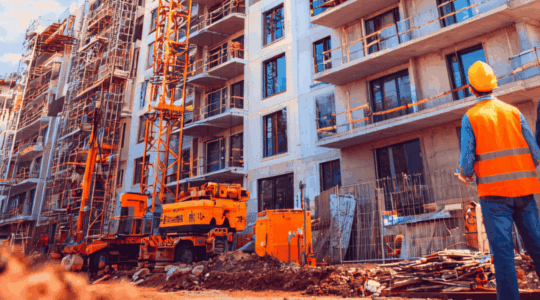Environmental
Navigating Environmental Risks When Establishing Start-up Operations
Identify potential risks and understand how pollution insurance policies respond to each stage of project development.
January 7, 2025
Your company has put you in charge of establishing its newest operation. Land is being purchased, designs are finalized, and a general contractor has been selected. The operation will be up and running in months, but a lot can happen between now and then.
Construction and development projects are subject to environmental risks. Environmental exposures are excluded from general liability insurance, so it’s essential to understand how to identify and manage these risks effectively at each project phase. This post highlights environmental risk issues and site selection, construction and operation considerations.
Stage 1: Site Selection
Consider this: You have found the perfect location for your operations. However, the seller requires an environmental indemnity related to any condition at the site, past or present. Should you make the deal?
Or how about this: You purchased land zoned for industrial use. A prior groundwater issue originating at the site was resolved two years ago. Your plans are commercial, with all above-ground construction. When applying for a building permit, you learn that a citizen group is protesting your development plan. Local zoning commissioners suggest you retest groundwater after construction to prove no ill effect. What if additional contamination is discovered? How costly could this be?
Whether purchasing or leasing property for your project, including the reuse of existing buildings, the focus at this stage should be to limit your environmental liability to conditions occurring after you take occupancy. This requires an understanding of any existing problematic conditions before you take occupancy. An environmental site evaluation will help you establish a baseline record of any preexisting pollution conditions on the site. “Pollution” includes liquids, gases or solids that could contaminate air, soil or water.
Never agree to accept as-is site conditions without first seeking advice from a qualified environmental liability specialist. Cleanup of identified preexisting conditions is often excluded from insurance coverage, leaving you responsible for resolving any issues. Retroactive dates allow coverage for some preexisting environmental conditions at the site, so request coverage prior to the date of policy inception to obtain as much coverage as possible, given the environmental conditions at the site.
Next, focus on protecting your business from the liability and cost of unknown existing and new pollution risks. The type of coverage needed at this stage is called environmental site pollution legal liability insurance, or PLL. PLL pays for clean-up expenses, third-party bodily injury and third-party property damage claims arising from pollutants, and legal defense costs.
To quote PLL coverage for the property, an underwriter will need information about the site’s historical use, the neighborhood demographics, the age and design of any existing buildings on the property, your future development plans and intended use, and your plan for managing any known environmental issues on the property.
Once the site selection is finalized, the environmental liabilities associated with the development and construction phase must be considered.
Stage 2: Development/Construction
Consider this: As construction begins, unexpected environmental exposures may be identified. For example, in preparing to pour footers, the contractor unearths piping, leading to an unknown, long-forgotten underground storage tank. Sampling verifies that the tank leaked contaminants that traveled through the soil into the water table. This groundwater plume heads downgradient towards the apartment building across the street. Residents must be notified, and indoor air testing is required in the basement-level units. Can insurance cover this cost?
Or this: An existing air exhaust system is upgraded. During an operational start-up test, the system fails, emitting soot and smoke beyond site boundaries. Emergency responders arrive to evacuate within a one-mile radius. An investigation reveals that the contractor did not install the early alarm system correctly. Commercial general liability insurance won’t cover pollution expense or injury. Are you prepared?
Before construction begins, consider whether on-site workers will perform activities that could create new pollution conditions or worsen existing conditions. Be aware that if the project involves setting up operations in a formerly idle facility, risks are high for discovering previously unknown pollution issues, aggravating existing conditions or generating new pollution issues.
Require contractors to provide proof of contractors pollution liability (CPL) insurance. Also, contractually require that your company is listed as an additional insured on the contractor’s policy to avoid contractor mistakes eroding your PLL limits.
CPL covers the contractor’s pollution liabilities arising from work at the job site (for the contractor and those hired by the contractor/subs). These include cleanup expenses, third-party bodily injury and third-party property damage claims. Remember that general liability insurance excludes pollution. CPL won’t typically contain known condition exclusions, as improper work can exacerbate known conditions.
Some project owners purchase an owner-controlled insurance policy (OCIP), or “wrap-up insurance,” rather than rely on contractors to obtain their own pollution liability insurance. In this instance, a single policy covers all contractors associated with the project. One benefit of an OCIP is that a higher insurance limit can be secured at a lower cost than if each contractor purchases coverage individually. Another is that if a claim arises, there is no debate about who is liable. The focus is on fixing the problem, not determining who is at fault and who should pay.
Before quoting a policy for this stage of the project, an underwriter will want to know the project’s expected start date and end dates, the type of construction, the location/geography of the project, the site plan details and the construction costs. They will also want to see the contract you have with the general contractor.
Stage 3: Operation
Once your operation is running, the focus shifts primarily to future environmental issues that could arise. Consider this: An unknown party dumps hazardous liquid waste into a dumpster, causing contamination and leading to clean-up and legal fees exceeding $150,000. Or a shut-off valve fails on an above-ground storage tank, releasing diesel fuel into a stormwater system that discharges into a nearby creek. The pollution kills wildlife. Remediation costs and natural resource damages exceed $1 million. Are you covered?
Or this: How likely is it that your processes or products may create a pollution condition? Could neighbors or tenants be affected? If something happened, would it impact your ability to conduct business?
PLL coverage at this stage includes cleanup costs, third-party legal defense, and bodily injury and property damages arising from operations. Endorsements can be added to your policy to address business interruption, crisis communication costs, indoor air quality including mold, transportation liability (e.g., a spill or accident while transporting goods) and contamination of non-owned disposal or temporary storage sites.
If products you produce or distribute could create pollutant releases, product pollution liability policy enhancements are an added feature to explore to provide coverage for issues associated with your products.
Before writing a policy, insurers will confirm your type of industry, anticipated revenue, building construction, building use and contents, product list, delivery systems, primary end users, and neighborhood demographics.
Partner for Protection
Environmental risk looks different at each project development stage. As a Hylant client, your risk management team includes environmental risk experts who can assist your project team with reviewing site assessments, construction plans and contracts to identify risks. They will also design custom pollution insurance risk transfer solutions to protect your operation at each phase. Contact us to learn more.
Download our free Underwriter Requirements Checklist for New Operations.
Related Reading: Using Site Pollution Liability Insurance to Close Real Estate Deals
The above information does not constitute advice. Always contact your insurance broker or trusted advisor for insurance-related questions.


